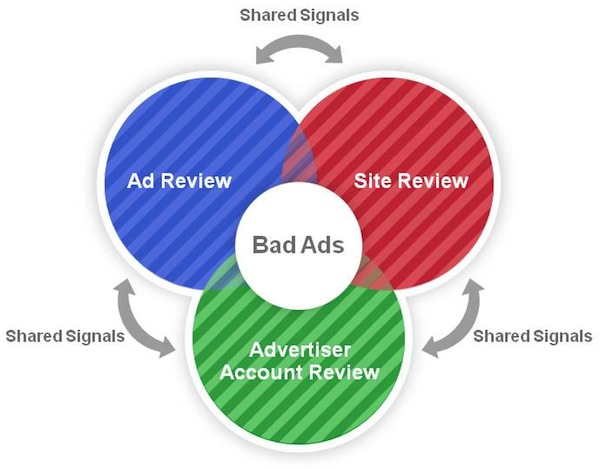
A couple of weeks ago, Google was facing scrutiny from lawmakers over their human trafficking ads policy. In response, Google has now shed a little more light on some of the systems it uses to prevent bad ads from showing up on Google’s search results pages.
We all know that Google doesn’t allow malicious ads, bad downloads, counterfeit goods, or ads with unclear billing practices. In order to combat these types of scam/illegal ads and human trafficking ads, Google uses a combination of automated systems and human input to review the billions of ads submitted to Google each year.
Google attempts to eliminate ad spam via what it calls a three-pronged strategy, where ads, websites, and advertiser accounts are reviewed. By looking at all three elements, it’s more likely Google can detect problems. All systems are complementary to the other three, sharing signals among each and comprehensively attacking and prohibiting bad ads from being displayed.
Google states that:
“… this three-pronged approach looks for patterns that would flag … a site and help prevent ads from showing. Ad review notices patterns in the ads and keywords selected by the advertiser. Site review analyzes the entire site to determine if it is selling counterfeit goods. Account review aims to determine if a new advertiser is truly new, or is simply a repeat offender trying to abuse Google’s advertising system.”
Ad Review
Google’s ad review system inspects both the individual ads and the landing page. If there is nothing in the ad or landing page that would “flag” the system, it will automatically start showing the ad as “Eligible” and show the ads only on Google.com to users who have “Safe Search” turned off.
If an ad gets flagged by a variety of different factors, it will show up as “Under Review” and receive a manual review. This review will include:
- Machine learning models.
- A rules engine.
- Landing page analysis to perform a more extensive examination.
- A real person to make the final decision (in some cases).
Website Review
Different ads can point to many different pages on a website. The site review system identifies policy issues that apply to the whole website.
Google will regularly crawl the sites and look for changes and updates. It’s intelligent and will learn from different scams and problem sites and flag potential sites with the same problems in the system.
Google stores the content of advertised sites and use both machine learning models and a rules engine to analyze the sites. The magic of this is that it understands all different languages and rules to analyze all different types of sites, then stores data and learns from it.
If Google’s system isn’t able to determine what the problem is, it will refer the problem site or pages to a real person to analyze. When a site is disabled, Google will tell the advertiser that it’s in violation of “Site Policy.”
Account Review
Many advertisers have ads pointing to different sites and pages. This Google system will determine which ads and websites need to be reviewed. This system “listens” to a variety of signals, such as ads and keywords submitted by the advertiser, budget changes, the advertiser’s address and phone number, the advertiser’s IP address, disabled sites connected to this account, and disapproved ads.
Google also pays attention to where advertisers log into their accounts from to see if anything is fishy. If an account is logged into in India and then in the U.S., it may flag the account or ads for a manual review. If the system can’t determine if the account is good or not it will pause all ads and flag for a manual review.
Despite all of this, there are still ads that get approved that shouldn’t be approved. Google says it’s doing everything possible to crack down on these bad advertisers (such as killing 130 million “bad ads” in 2011) and are constantly investing their time and money into improvements to stop negative ads.
